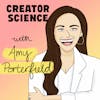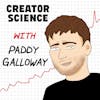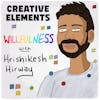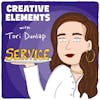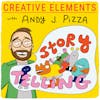
#49: Corey Haines of Swipe Files – Five pillars of growth and a tactical guide to sharing your work on Product Hunt
Play EpisodeCorey Haines is the creator of Swipe Files, a membership site that provides content, community, and courses to help you master marketing.
Corey Haines is the creator of Swipe Files, a membership site that provides content, community, and courses to help you master marketing.
Corey curates marketing examples, copywriting help, and more through his newsletter, membership community, and podcast.
In this episode we talk about Corey’s five pillars of Growth, how he achieved early traction with Swipe Files, why he decided to go full time, and a complete strategy for using Product Hunt to get in front of potential fans and customers.
Click here to join Swipe Files. Save 50% by using promo code "ELEMENTS"
Transcript and show notes can be found here
***
LISTENER SUPPORT
Join our community on Facebook
Support this show through Buy Me A Coffee.
***
SPONSORS
Try Podia and save 15% for life as a Creative Elements listener
Start your free trial of SavvyCal and get your first month free using promo code ELEMENTS
***
ABOUT JAY CLOUSE
Subscribe to my weekly newsletter
Follow Jay Clouse on Instagram
Enroll in my course on podcasting, Podcast Like The Pros
***
PODGLOMERATE NETWORK
This show is a part of the Podglomerate network, a company that produces, distributes, and monetizes podcasts. We encourage you to visit the website and sign up for our newsletter for more information about our shows, launches, and events. For more information on how The Podglomerate treats data, please see our Privacy Policy.
Since you're listening to Creative Elements, we'd like to suggest you also try other Podglomerate shows surrounding entrepreneurship, business, and careers like Rocketship.fm and Freelance to Founder.
Learn more about your ad choices. Visit megaphone.fm/adchoices
Corey Haines 0:00
What's that one thing that silver bullet that you know, magic kind of pixie dust that you can sprinkle over me and help me to grow? And it really got me thinking and I wanted to answer that question.
Jay Clouse 0:12
Welcome to Creative Elements, a show where we talk to your favorite creators and learn what it takes to make a living from your art and creativity. I'm your host, Jay Clouse. Let's start the show.
Hello, welcome back to another episode of Creative Elements. You know, every week on this show, I'm talking to creators who are finding a lot of success. And a common topic that comes up is growth. Somehow, some way, all of these creators I talked to have some period of growth that fuels their ability to do their work at a really high level, usually full time. And I'm always trying to dig into why did they grow? What did they do to unlock growth? Growth is this really sexy concept that most creators and entrepreneurs are chasing all the time. So today on the show, I'm talking with Corey Haines, because he spent a lot of time thinking about and working on growth.
Corey Haines 1:20
So as the head of growth at Baremetrics, primarily did SAS analytics, we also had a couple of add on products like recover and cancellation insights, which helped with churn and retention and preventing failed payments, things like that. But I was the head of growth. And I think I joined as team member number eight.
Jay Clouse 1:38
As you just heard. Baremetrics is a software as a service or SaaS company that works with other SaaS companies to help them understand and further fuel their own growth. And as a head of growth at a SaaS company focused on growth, Cory is an incredible wealth of knowledge on this topic. You may be thinking, wow, head of growth, that sounds like a really intense and valuable job. But what does that actually mean?
Corey Haines 2:02
Basically, head of growth is a really fancy word for all things, marketing, sales, and a little bit of customer success as well.
Jay Clouse 2:10
We've been talking a lot about software here. But I want you to trust me, because the approach that software companies take is really closely aligned with the path of creators. After all, software is a product and so is anything that you create, writing, photo, video, podcast, all of it, and paired closely with the concept of growth is marketing. Which brings us to what Corey is doing today, because Corey is no longer the head of growth at Baremetrics. Today, he's a full time creator with his own business called Swipe Files.
Corey Haines 2:40
Swipe Files was actually born from something a little bit more personal to me, because in my experience as the head of growth, I was constantly trying to spin up new experiments, new pages, new channels, making tweaks here and there. And I always felt like I was starting from scratch. So Swipe Files was basically my attempt to say, you know, I'm sick of this whole like reinventing the wheel. I want to have curated examples. I want to know why they're good. I also want to have a strong community that I can rely on to ask people for this again, I was like dming people and sending emails and like just didn't feel like a scalable way for me to ask for favors of people in a very collaborative way. Like I want to be able to return the favor as well.
Jay Clouse 3:19
Swipe Files is a membership site that provides content community and courses to help you master marketing. Corey curates marketing examples, copywriting help, and more through his newsletter, membership community and podcast. I just joined Swipe Files myself, and Corey is offering listeners of this show 50% off. More info is in the show notes and at the end of this episode, but I wanted to talk to Corey about what he's learned related to growth and how he utilizes a platform called Product Hunt specifically, as a really effective marketing channel for his work. So in this episode, we talked about Corey's five pillars of growth, how he achieved early traction from Swipe Files, why he decided to go full time, and a complete strategy for using Product Hunt to get in front of potential fans and customers. This episode gets super tactical, and I'd love to hear your thoughts on it as you listen, just let me know your thoughts on Twitter or Instagram by tagging me @JayClouse. But now, let's talk to Corey.
Corey Haines 4:16
The head of growth definitely is a is a daunting task. Because I think actually traditionally, when you think of growth, especially like think of growth hackers, and you think of like a growth product manager at a lot of consumer focus kind of apps and sites and products are for me being at a b2b software company that was bootstrapped mainly and was, you know, not on the venture route. Head of growth looked very differently. So, you know, look at other people in their growth titles, and they're doing things like basically, conversion rate optimization. They're doing, you know, Product Management kind of work, and they're doing these really like micro experiments of the cliches button colors, but you have things like different user paths and interfaces and things like that. But that was not at all what I did. For me head of growth is mainly how do we grow revenue? How do we grow revenue efficiently? And so that's where the marketing and sales comes in. And yeah, it was a big task. I mean, it's, it's essentially, a you are responsible, incentivize for all things, increasing monthly recurring revenue, MRR. And I can't say that it didn't stress me out a ton. But really, my approach was just to take things day by day, to work through it. And day to day, what it looked like was mainly, I was doing a lot of demos and talking to a lot of customers and trailing users every day. And so I got to talk to about 10, to 20. founders and operators and marketers a week, usually, and looking through their account, answering questions, trying to give helpful strategic advice to them, and then growing Baremetrics. So doing marketing experiments, creating content, spinning up new kind of programs, and then working with our customers as well. And so we had a very lively customer base, a really active customer base. And so there's a bit of upselling, a bit of education, and also using them as a resource as well, for everything that we were doing.
Jay Clouse 6:07
Head of growth has always seemed like such an intense title to me where like, it feels like you're putting a lot of trust or like a lot of hope on the back of this person. So when you came into that role, how did you position yourself as somebody that could do growth well, and could help a company grow?
Corey Haines 6:24
How I position myself was, I'm a kind of a jack of all trades a little bit? Not really, I mean, I think I can I'm not a master of none, one master of some things. But a jack of all trades can come in and take a full funnel approach, take a holistic approach across marketing and sales. And usually what you find with a lot of marketers and salespeople is that they're very specialized. And so given that it was a small company, given that we wanted to have a very full funnel approach, it seemed like, Well, I was the best fit for the role and what we wanted to do.
Jay Clouse 6:52
I think everybody in the world want to growth in some way, right? So I would imagine you probably have, whether it's startup founders or creators themselves coming to you and saying, like, I need to grow, how do I grow? What does that look like? What are the questions, you run them through the ways of thinking that you you challenge them to think about if if they want to grow, because growth seems like an obvious thing we all want, but I'm sure it's super context specific.
Corey Haines 7:16
Oh, yeah, yeah. And I learned that lesson really quickly. Because immediately once I started talking to customers, one of the first things I did actually, when I started Baremetrics, was I just sat down, and I talked with about 20, or 30, of our best smile at most active largest customers. I just tried to get to know them. Personally, it wasn't like an interview or an interrogation. It was just, Hey, I would love to get to know you. And how do you find Baremetrics? And how do you use it and tell you about everything else going on your business? Like not Baremetrics related or not metrics related? I'm just trying to get to know them. I mean, even from those first conversations, it was, hey, you must talk to a lot of people like me, like, what are you seeing work for other people? And how are they approaching it? And what are other people's metrics like and what are you telling them to do? Like, well, what's working right now, everyone's always wants to know, like, What's that one thing, that silver bullet that, you know, magic kind of pixie dust that you can sprinkle over me and help me to grow? And it really got me thinking and I wanted to answer that question. Obviously, it is very prescriptive. But really what I landed on over time, as it kind of evolved, was really these five kind of core pieces. So one is the market. And the market really determines a lot of your growth, whether you like it or not, because we're seeing this with with COVID, with a pandemic. But overnight, we saw a flip to really prioritize remote tools and collaboration tools. And online video conferencing like I've I've talked to, I know several startups in the space, who are around, you know, video conferencing and recording and, and they're just having explosive growth because the market dictated that one of my favorite examples also is Gumroad with Sahil because he raised so much money, created a fantastic product hire to generous team, but they weren't growing fast enough, even though we're doing all the right things and had all the right ingredients. The market just wasn't there for the creator economy, you know, seven, eight years ago, whatever it was when he started it. And so but over time, you know, he had this really tragic story of like, got this really slammed prps after a bunch, let a bunch of people go, I think they got like a quarter of the team. He had like this really strong bout of depression kind of like left the company for a while. But it continued to grow because the market was growing with him. And now you know, we're seeing the creator economy just explode.
Jay Clouse 9:28
I spoke with Sahil of Gumroad and Episode #31 of Creative Elements. And he talked about this change in the market that Corey is describing here. What Sahil talked about that has stuck with me is that as a market expands or reaches scale, it becomes more reasonable or even inevitable that new tools are created to support that growing market. And that's what we're seeing with this "creator economy".
Sahil Lavingia 9:50
What scale does is it creates an economy and it creates like a market for people who build tools. And so when you have scale, you get better tools made right like Figma Canva and all of these tools that didn't exist five years ago, even. And that creates, makes it easier for more people to get in, which allows even better tooling to exist. And and and sort of the cycle continues and continues. So when you have the means of creation creates more creators creates an economy that creates more means of creation.
Corey Haines 10:15
So anyways, the market is definitely one big part of that. So I always try to get down to Hey, who are your customers? And like? Do you really know who they are? And who do you best serve? And how do you go reach them? And what is it like how many people are like this? How much money do they usually spend on a product like yours? And then we get into the product, obviously, because you need to have something worth selling and worth giving to people. And so we usually talk about, you know, hey, what are the kind of like killer features that you have? And are there unique differentiators? And can you really deliver on the promises? And what our competitors doing better that you can, things like that? What advantages Do they have, and then we get to the model. And this is the one that most people overlook the most. But the models, essentially what I categorize are split into your activation model, which is how you get people into the product. And then the pricing model, which is how you charge them for using the product. And most people are just kind of like set a price and set an activation model and then just forget it and leave it. But what I found there's a lot of opportunity there because it has to do with, especially for a software product, which is very utilitarian, and it's very, like outcome oriented, where like, does this thing help me? Or does it not help me, it's all dependent on the activation model, and is it worth paying for the pricing model to get people in. And a lot of people overlooking onboarding, they're overlooking, even, you know, they think, Oh, I want to set a free trial, when in reality, people want to use it for free for a while without a time limit. Or maybe it's the opposite of like, I'm gonna give people a free plan. They're really what they need. And what they want is to talk to someone to walk them through it, they want a personalized kind of concierge onboarding. So I tried to tell people to tailor the activation model to how their customers are already behaving, rather than what they want, right, you have to be customer centric. And then pricing is a whole other thing I won't even get into. But there's always optimizations for your pricing model for increasing pricing. I remember I talked to someone who he had launched 10 years prior to our conversation, and he was charging $2 per user. And he hadn't changed the price once and all of his competitors were charging, I think up to $20 per user. So I was like, Look, man, if you want to grow honestly, I'll just double the price, triple the price, quadruple the price, like start somewhere. So anyways, that's a really extreme example. The fourth bit, and I'll get through these a little bit quicker, but is um, messaging and positioning. Because at the end of the day, if it doesn't click for someone, where they understand how you're unique, who they serve, what it's like to get started, and if it's something that can help them, then it's all for not it's a it's a moot point. And so this is where copywriting comes in, especially positioning. I love April Dunford obviously awesome, because it's just vastly overlooked and vastly underutilized. But you get all these kind of jargony words and cliches and people always want to jump straight to like these very ethereal kind of value propositions, but just get brass tacks position yourself really well for your market, and communicate that well. And then we get to the channels. And everyone always jumps straight to the channels. And that's why I leave it last. Because it's what things are you doing in our, do Facebook ads work? And does SEO still work? And should we try this, should we do that. But again, everything is for not on the channels, if you don't have your good positioning and your market, if you don't have a good product, if you're pricing activation models and good if you don't have a clear, compelling offer, where you can describe it well, and people understand and it clicks on the website. And so then then the channels is kind of like the last thing that's the least interesting of them all. But of course, I asked, you know, just actually right before this, I was talking to someone, and he really had to think about for also for a year model, what kind of channels are good for you, because you can't expect to onboard people one by one, if you're charging them $2 per month, or even $9 per month, maybe in the early days, right. But for a higher price product in general, you need more kind of hand to hand combat, so you're gonna have to do more sales, you're gonna have to go to events, you're gonna have to just run some ads to get people interested. Whereas if you have a more lower price product, you'll probably need to do more content and more PR, more referral marketing, a little bit more, you know, scalable, non hand and hand combat type type of channels. So I walk people through those five, and usually we start to uncover some major themes or where people can get started and how to grow.
Jay Clouse 14:27
After a quick break, Corey and I talked about the beginning of Swipe Files and taking the leap to going full time. There's a lot that all creators can learn from here. So stick around, and we'll be right back. Welcome back to my conversation with Corey Haines of Swipe Files. During his time at Baremetrics. Corey really formed this theory of these five pillars of growth, market, product, model, messaging and positioning in channels. It wasn't long until he started to form the idea for his own product.
Corey Haines 14:56
But one of the things he wanted to do for Baremetrics was starting affiliate program. Just an experiment I thought, you know, there's some people in the space consultants, some agencies who, you know, might be financially incentivized to share Baremetrics, so we can build a really strong partnership and do co marketing. But I was like, Well, what is affiliate? What is a good affiliate marketing page look like for a SaaS company for a b2b SaaS company? I have no idea like, I need something to draw from. So I go and ask people I post on Twitter, I tried to make some connections here and there. And eventually, I found some examples. But then I also wanted to know, Hey, why don't you design it that way? Like, why did you include these sections? Does this work for you? Does this not work for you. And so I had to do a whole bunch of work just to figure out the foundation of this one thing of like, how to create a landing page for your affiliate program as a SaaS company. And like you saw, you multiply that across all the different pages and emails and ads across all the different industries and types of businesses and products. And it gets really overwhelming. And you're like, Wow, I can't believe I have to do so much work, just to kind of reinvent the wheel every single time. So that's, that's a little bit more of where Swipe Files was born.
Jay Clouse 16:00
I love that second level of not only do I want to see what people are doing, but I want to know why. And also, is it working? Like so often we see what other people are doing. And we just kind of assume that it's working. So we mimic it, and then it's not working.We're like, why isn't this working? And maybe it wasn't working for them in the first place, either.
Corey Haines 16:17
Oh, 100%, I mean, we see that so often a marketing is, is way, way easier to copy and imitate. But what happens is, it's kind of like the telephone game, you know, are you like us or something to the person next to you. And then, and by the end is something completely different. And that happens in marketing where someone creates this really beautiful landing page, like stripe, for example. And then everyone goes and copies it. But stripe can do things that you can't do, they can afford to make kind of like skip over these like rules and best practices. Also, there might be completely different than you and your needs. And so it has to all be very contextual. We've seen this even with a lot of SaaS landing pages, just in general, where they're just like these really ethereal pages where you're like, I don't even know what this does. And you leave the page thinking like, I have no new information, like I'm more confused now than I was before. And it's because everyone's all they get all cutesy, with the illustrations. And the easiest, really, you know, big value propositions around, it's gonna change your life and saves you time. And you're like, Okay, so what to do? Like, what's, what's the main feature? And who is this for? Like, am I am I even the right person for this. So 100%, it's easy to copy without even knowing if it works or not.
Jay Clouse 17:28
Jumping in here to say, again, I know Corey is talking a lot about software companies here, when he talks about landing pages, this is actually super relevant to any creator who has a public facing presence, you need to make it super clear to the reader or the visitor, what it is that you do, and for whom, if you don't make a quick impression on the viewer, and they don't leave with a good sense of what you're about. That's a completely lost opportunity. So I love this concept Corey has come up with a finding and sharing the context behind these different campaigns and design decisions. Swipe Files seems like a pretty great idea. So I asked Corey, when he knew his time to leave Baremetrics and go all in on Swipe Files full time.
Corey Haines 18:06
I knew that I had some initial attraction, I'd also been itching for a long time to kind of strike out my own and fulfill my own kind of entrepreneurial appetite. And through through the pandemic, I think especially I learned like, I really just want to do something different. I want to get out of here, I want to put it on my own. I felt like I'd gotten through the pandemic. And I was like, well, it's not gonna get any worse than this. And so if I'm gonna make this leap, I might as well make it now and then things will get better over time. And so with attraction with Swipe Files, with all the idea, like I just came to a point, I think especially where I thought there's no way I'm going to make the progress I want to with the time I have doing this on the side. And I would regret not putting the time into this. And so it felt like a turning point.
Jay Clouse 18:52
How long have you been doing it on the side? And or what have you developed to that point that you were able to get some traction?
Corey Haines 18:59
Yeah, I'd started officially working on it in March of 2020. So basically, right in the beginning of the pandemic, the backstory to Swipe Files is that I had this idea for it. And I keep a big log of startup ideas and content ideas and whatnot. And I'd fallen started on this guy named SoCo on Twitter, who was creating these amazing prototype recreations in Webflow. So we created this ps4 prototype within Webflow. So I started following him, he got a bunch of kind of attention, wanting to do a giveaway to build someone's site or prototype for free. I won along with a whole bunch of other people. And we ended up making this into this, no code Rumble, quote, unquote, we're all kind of work together to build something. So that's when it kicked off in March. So giveaway was in end of January of last year, started working on it in March. I think by the end of April, I had officially like made it live and got my first customers. And then by September, I'd released about 50 tear downs and had about 100 members And then I just started working on the community. And so that's where I felt like, Okay, if I'm going to really get this thing, everything that it needs like, and I got this much traction just with this one thing, which is tear downs. Like, I think I can make it work with all the other things I have in mind.
Jay Clouse 20:14
So with Swipe Files, you have content, I'll loosely call it, you have a community? How is that similar or dissimilar from like a SaaS product? In your mind? Now that you've seen both, you know, you mentioned these five pillars of growth, with market product model messaging, positioning and channels, how much does that map for a content in community business?
Corey Haines 20:35
Yeah, it really is quite similar, because it's subscription based. I think that, that those kind of five pillars of growth maps really well to any subscription base products, mainly for SAS and b2b SaaS, kind of like my world and where I've come from, but it really does. And I think that's where I've kind of honed in for myself, like my market is other marketers, and entrepreneurs who are doing marketing for their business. The products now is kind of what I've been focusing a lot on. So the product now did expand, from tear downs, to community now to newsletter to also courses. And now at this like kind of master Swipe File quite literally have a whole bunch of curated examples of I think have 1500 plus now at this point on a notion doc. And then with the messaging, or I'm sorry, at the model, it's 100 bucks a year. But now I have this all access pass. And so there's some some tweaks there as well. But for a while, also I was doing with the latest teardown was free. And that really helped because I could kind of get the benefits of releasing something out there for free to get a lot of attention and get people interested in it. But then once the next one came out, then it would kind of go into the archive and be members only. So that's where it's pretty well as well. messaging and positioning. That's certainly a tough one. But I think you've kind of nailed it now with content community and courses, helping out master marketing. And it's basically a find your people, here's the hub for if you're a marketer and want to level up your marketing game. And then the channels now has been the interesting part, with the newsletter with with a little bit of blogging, my own personal Twitter following.
Jay Clouse 22:07
How methodically knowing what, you know, did you go through those things? Because someone listened, this is probably like, okay, here's the playbook. I'm gonna go through one by one. And it kind of sounded like there was a intentional order there. Were you able to hold yourself to that also. And now you're on like the channels part of it? Or did you do a lot of us do, which is like jump straight to channels? Like you were saying?
Corey Haines 22:27
Yeah, no, I very much did that. I thought, for the market. I am the market for myself, I'm building this for myself. So I kind of felt I already had that one down. But still at the same time for the tear downs, which is what I started with. I asked people one by one over dms and emails and or phone calls. Hey, like, do you like reading tear downs? What is it? What do you like about it? What do you not like about that? about it. And a lot of people said they love reading them. But there aren't enough of them. But they also don't like the kind of like blog format of them. They don't like that it looks like any other piece of content. So that's where came up the idea of like this very, it's very like blocked out on a page. So it's like image, paragraph, image, paragraph, image paragraph all side by side. So that's how I sort of tailor the product to the market. The model again, I went through because I knew that if I just locked it down from the beginning, as members only, I wouldn't get any traction. But if I could give it all away for free, and then I put it in lockdown, that might not also be a good experience for my audience and for those people. So that's where I came up with the idea for that the latest teardown would be free. But I've also thought about that very intentionally now for the membership with the community as well, because it's part of my core thesis with the community being that there's a whole bunch of free marketing communities out there. And they suck because they're free. So I'm going to make a paid and and we're going to go through a free trial and introduce the trial out to people say, Well, I want to you know, experience it introduce myself before, you know, deciding and that's a thing I'm happy to give away for people. So yeah, absolutely. I've gone through each of those. And really the channels is we're just getting to now with being more intentional about drawing attention to it, building up my following and getting more members in the door.
Jay Clouse 24:05
And so now we've come to one of the main reasons that I wanted to have Corey on the show today. For the last several months, I've noticed just how good Corey is at utilizing a platform called Product Hunt as a channel for sharing Swipe Files, as well as another really great product he works with called SavvyCal Product Hunt has long been a platform that I've had interest in utilizing. But it seems like there are a lot of insider tactics to be aware of if you're going to use it well. We dig into specific Product Hunt strategy here soon. But I'll let Corey explain more about what Product Hunt is first.
Corey Haines 24:36
Product Hunt is basically a site and a newsletter that started by Ryan Hoover. Way back in the startup days of yore, I think I don't know in the early 2010s then, it's really evolved into like the place that you launch tech products. It's actually interesting kind of what their own evolution and positioning because I think they originally wanted to branch out into like, books and content and podcasts and basically like the place to discover anything, but where they found the most traction where they've really found their communities within tech, and especially with like makers, people who are creating sites and software and widgets and things like that. And so really Product Hunt is, is kind of like this front page where every day new products get launched, were hunted, quote, unquote, even though the hunting isn't like a huge part of the whole process these days, and they get featured on the page every day, and then they get uploaded. And so you have like this hierarchy of here, the top products for the day, here's the top product for the day. And then the next day, it all starts over. And there's new products launched. And so every day, there's this new feed of products that are hunted and featured and launched there. So for the tech community, it's really been a place to initially it was very much like, this is where you, you get your first users and you launch it, and it's discovered, and so you just kind of get it as like early traction. These days, it's a little bit more of a place to kind of like, make your big splash. And really, really use it as a marketing channel to get customers and not just like early users, and to really kind of fight for that top spot. Because they have this big newsletter now, which it goes out to there's a lot of influencers in the space, they have a ton of traffic, and so has a lot of potential to kickstart your marketing to get a lot of users and customers.
Jay Clouse 26:18
I've always looked at it as like a tech place, which is part of the reason why I haven't used it much because it felt like is this for me. But you know, here I am. And I'm hearing you talk about your products for Swipe Files, your products being content, your products being community, that's very much the lane that I'm assuming in a lot of people listening to this, there's joining in. So does that work on Product Hunt?
Corey Haines 26:39
I think so to a certain degree, again, kind of thinking back to that first pillar of growth, which is your market, it mainly just about are my people on Product Hunt. I mean, really, for Swipe Files, it's a membership community, its content at the end of the day, it's not like a lot of the other tech products where it's, you know, GTB three and a new SAS app or some sort of like cool Chrome extension or something like that. But there are marketers and entrepreneurs on Product Hunt. So as long as I think that if you know that your people or your type of people are on a Product Hunt, then it can work for you now, to what degree I don't know, I didn't get the top spot on Product Hunt. I got number two for the day.
Jay Clouse 27:17
That's pretty good.
Corey Haines 27:18
Thank you very much. Yeah, it's very good, I think for I pulled my weight compared to a lot of other ones. But the part of the beat was actually a friend. And it was headline, which is a GTP three powered copywriting app basically. And like, I'm not gonna beat that there's no way because it just appeals to that audience more organically. But I managed to drive a lot of people to Product Hunt, which managed to get me in front of a lot of other people on Product Hunt because I had that top spot there. So I'm not gonna say that it works for anyone and everyone producing content base products or kind of business or sites. But if your type of people are on there, if you have a way to drive your people to prototype, especially, you can make it work to some degree or another.
Jay Clouse 27:59
When we come back, Corey and I get super tactical into the strategy, he's seen work for launching something on Product Hunt. I found myself taking a lot of notes on this, and you might do right after this. Welcome back. After seeing Corey become a top product on Product Hunt for both Swipe Files and SavvyCal, I knew he would be the guy to ask about specific strategy that other creators like you or me could put to use. So I started getting really specific, asking questions like how many products get posted on Product Hunt every day?
Corey Haines 28:29
I couldn't tell you exact numbers. I do know that not every product posted makes it to the front page on Product Hunt. I found this out actually, when I first launched on Product Hunt, my job board just for marketers called Hey Marketers, and I posted it. Like late in the day. It was like 9am because I had fallen asleep the night before trying to stay up from midnight to post it. And then it was on there. But everyone was like I can't find it on the front page. So I was like, What the heck and dm them like, Oh, well, we'll add you to the front page. And I was like, interesting. I didn't know that. That's how it worked. So I don't I don't know if there's even a way for like me as someone not behind the scenes on Product Hunt to know how many actually make it onto the front page versus are actually launched. But I know for the ones that make on the front page, there's usually 20 to 30. So I'd assume there's probably anywhere from 30 to 100 products launched every day on Product Hunt.
Jay Clouse 29:19
You said something interesting just now which was you launched late at 9am. What does that mean? That sounds pretty early to me.
Corey Haines 29:26
Yeah, so so the clock resets every day at midnight pacific time, which is where Product Hunt was based. So essentially, as soon as the next one starts then the old products for that for last day, you know, go away and now we have kind of open range. It's open for anyone to post for the new day. And so I posted late because by that time there was already you know, 30 ish other products on there. They already had a photo and styled kind of like I'm fighting upstream like I'm gonna have to make up for lost ground because also at midnight, when the clock resets, now there's new people coming to the site who are looking for products, to discover and to upvote. Right. So it's actually a really key for product testers maybe like, the most key thing, as silly as it sounds, to launch exactly at midnight, because the earlier they're there, that you're there, the early you can get votes to your product. And the earlier that you can take that top spot compared to the other products, and then it's much easier to defend your spot as a as a top place than it is to get there and like overtake everyone else in the top place.
Jay Clouse 30:34
Super interesting. I learned a little bit about Hacker News last year, and it's a little bit different. Like we realize what that strategy, you wanted to post it when people were actually on the site looking at it, because then you have a chance to be like picked up in the first five minutes that it's alive. Whereas here, you're saying, like you want to maximize the amount of impressions you can have in a 24 hour period. So if I'm on eastern time, I want to be posting at 3am. Eastern my Product Hunt launch.
Corey Haines 30:59
Exactly. Yeah, that's that's exactly what it is. So me living in San Diego, I'm at an advantage because it's only minette. For me, if you lived in Hawaii, it'd be 9pm. And you'd be you know, be in easy breezy for you. But for example, when I helped Derrick Reimer launch SavvyCal, I'm consulting with, he lives in Minneapolis. And so he actually I set up for him and kind of did some of the grunt work when midnight struck pacific time. And he happened to wake up at 2am his time to kind of like check in and post a couple things. But yeah, that's the reality of it is it's it's pretty important to just hit the ground running and get started as early as possible. And that was really key for me for Swipe Files. And for SavvyCal and both our launches.
Jay Clouse 31:38
Something else has been kind of holding me back with Product Hunt is I didn't know when in the products lifecycle it's appropriate to put the Product Hunt, does it have to be something that's just launching a new version or like take this show, as an example, Creative Elements has existed for almost a year? Have I missed my window to post on Product Hunt?
Corey Haines 31:55
Not at all, yeah, you can post as late as you want, you can launch quote unquote, as late as you want on on Product Hunt. And in fact, I think it's actually advantageous to launch like later than you would think to you. Especially when you have some sort of audience and familiarity familiarity with your product already. For example, with Swipe Files, I already had a newsletter of, you know, a couple 1000 people, I already had a, you know, core base of about 200 members, I had my personal Twitter following, which is a couple 1000 people. And so me launching into prototype, especially for those people, I can get them to say, Hey, I'm on Product Hunt today, please go share, right. Whereas if I didn't have those initial like group of users, I would be, you know, speaking into the void, I would have no one to share my stuff without to go down well, my friends and stuff. And so it's actually good. I mean, same thing with SavvyCal, like, we had several 100 users. And a large portion of those directly from the email, went to Product Hunt and uploaded, commented, you know, give it a review, give it a share. And so it's never too late for sure. And it's probably a little bit advantageous. And this is kind of again, where it comes back to you. I said before where prednisone used to be like, this is where your product starts. But now it's a little bit more of like, this is kind of your opportunity to make a big splash and gain a lot of users and customers rather than like that initial traction. So it definitely helps to already have something established and then to launch later.
Jay Clouse 33:19
Okay, so let's say I'm gonna keep using the show as an example, because it's easy to latch on to have 1000s and 1000s of listeners, for every episode, get 1000s of people on an email list, got a small Facebook community for the show. If I post is at 3am Eastern, do I try to push those people to go engage with it right away? And in what way? Should they engage? Is it just like uploading it, it's sharing something meaningful?
Corey Haines 33:45
Yeah. So there's a little bit of taboo and a little bit of like some rules that you want to abide by, like, You're not supposed to directly ask people to upvote but it's a little bit implied, right? So you can use some words like can you please, please go support us on Product Hunt? game, please go leave a comment. And while you're at it, you know, leave a review or something like that, especially on social media. You don't want to even use the word upvote. In your email, you probably you can get away with it to be honest. But yeah, absolutely. So when first Swipe Files and for SavvyCal, we had tweets scheduled, we had the email scheduled, and we had the announcement, sort of like go live at 12:05am pacific time. And that way again, we can get that ball rolling, and drive people immediately to it so that we can ask them to comment upvote to leave a review as early as possible to get that traction. So I think if I remember correctly with with SavvyCal especially, we had like 50 of votes by like a 12:15. We're in the number one position just from like those initial tweets and email.
Jay Clouse 34:48
Wow.
Corey Haines 34:48
And then like from there, it wasn't that hard to be honest. So like keep that up. We we ended up losing that top position within like the last two hours of the day when we launched to like another product which kind of had a suspiciously late run in the day for all the folks that they got. But it wasn't hard once we got that initial traction, it sound a little bit crazy. See what this is what Derek and I talked about, he was like, we're gonna send an email at midnight. And I said yes, because a lot of people are, you know, over in, like, in the UK and Europe, or even in, you know, Australia, Asia, and it's the middle of the day for them, or it's the morning for them. So it's fine. You have night owls, like myself, who are up late and checking email late for some reason. It's just like a crazy habit. But the initial traction is so important. And you can even send another email, you know, more tweets throughout the day. But sending it as early as possible really is key to secure those early that early traction.
Jay Clouse 35:39
So talk to me then about the actual Product Hunt page, or whether you call it a campaign itself. I know there are like hunters versus makers. Can you explain that?
Corey Haines 35:48
Yeah, so the makers are the people behind the product. And so that, for me, it was myself. For SavvyCal it was Derrick the founder. And then we have hunters. So you can hunt your own product as the maker so I could have hunted Swipe Files. Derek could have hunted and SavvyCal. But a hunter is someone who basically lists your product for you. And so they have a separate prototype account, obviously, and profile them also, they might also have followers within Product Hunt. And how Product Hunt works is that if you can accumulate followers, just like any other social platform, and then anytime that you hunt something, it will notify the rest of your followers. Now I don't actually know if it's that important or if is that effective. But the real advantage of having a hunter is kind of like a halo effect. So if you have a Chris Messina, for example, hunt to your product, he has hundreds of 1000s of followers on Twitter and other social platforms. He's very well known in the tech space. And so you kind of you can leech on to his trustworthiness and his brand and how people know him, right? It's a little bit of influence marketing a little bit. So I had Heaton Shah, who also is very well known in the tech space in the startup space, he's an investor entrepreneur, on top of Swipe Files and SavvyCal and advanced for him as well as one he gets to hunt it. And I don't know the exact terminology for it. But a lot of people speculated that Product Hunt has like a whitelist, essentially, of like, whenever these people hunt, it automatically goes to the front page and like gets a little bit of like organic boost, essentially, like they just automatically kind of send it through. Again, I was not on the whitelist when I first launched on Product Hunt, that's why I probably didn't make it to the front page and had to ask for it once I was kind of verified and interviewed. But the real benefit to the hunter is you get their exposure to their social following usually is the big one, whether or not the notification to their followers on Product Hunt is effective. I'm not exactly sure. But you get the halo effect from them. Absolutely. And then the page itself is kind of like a combination of multimedia like videos and images, you have kind of an initial post where just kind of a quick description of what you are as a couple of tags, you can link out to your site or whatever place you want to send people to. And then there's a list of comments. And you can also be like the first comment as the maker, as the hunter and describe you know, what it is and why you're launching and what people can expect. You can also include like a deal, especially for for product and people. So what we did for both Swipe Files and SavvyCal was, we did a really quick like, two minute walkthrough from myself and Derrick, where we would walk through our products on video and just like a really quick loom video, or I use Soapbox by Wistia. So it's just like a side by side, my face and screen share of the product. And that allows people to get to know me and really see me and it's very quick to kind of skim through. But then there's a couple other images that just highlight sort of the features, if you will, and then you have all the comments below of everyone else. So in the first comment, it's just me introducing myself, hey, here's the problem I was looking to solve. I was sick of reinventing the wheel, etc. Everything I just told you. Here's the solution. It's a we have content, we have courses, we have the community, we have this access to this database, etc. And that's really the core of it. I mean, it's not terribly complicated. It takes about five minutes to list it there. As long as you have all the right ingredients.
Jay Clouse 39:11
How would you rank or prioritize the importance of like, do you think video is the way to go? What other images Do you think you should include? How important is the thumbnail image, little square thing that I see on the page? How much how much weight do you put on those ingredients?
Corey Haines 39:24
For the actual listing, the video and the images are probably the most critical part of the whole thing. The thumbnail, I don't know if is, is super interesting. Like if you can have a fancy GIF with an animation, it might you know, attract a couple more users. But really, it's it's not a huge kind of part of strategy. It's not if you just have your logo, like that's totally fine doesn't need to be terribly creative. But yeah, I mean, I think the video videos optional, but I think that helps, like, definitely stand out. And a lot of people like watching a video from the founder. But the image is definitely one of the most important kind of key parts. And really, you don't want to just throw up any old screenshot. You want to really put your best foot forward. So you're showing, you know, for me, I'm showing the most interesting parts, which are the community, the database in Swipe Files. I'm talking about some of the other features and ways that members are interacting with one another. For SavvyCal like these are like the coolest features, here's the calendar overlay, here's the personalized links, etc, etc. But that's really it. Yeah, there's not a lot to it. I mean, it's, as long as you have those things set, they're high quality, that the right dimensions, they're showcasing what you want to stand apart, then it's not rocket science, anyone can do it.
Jay Clouse 40:33
So if I'm sitting here, and I'm thinking, I can make all these things, and I feel good about my product, but I don't have connections to a whitelisted, or high profile hunter, should that hold me back? Should I spend time looking for that person or building a relationship, or should I just let her rip?
Corey Haines 40:50
I think that it's always worth putting at least a little bit of time into it. Chris Messina, actually, he has like a specialized page on his site where you can book a time for him to heighten your product. And then you can tip them, you know, buy him a coffee. So there's always him you can get on his calendar. There's also a couple sites, I forget what they're called. But it's like, you know, top hunters, there's like a list of like the 500, top hunters on Product Hunt, you could kind of work that list and go down, but absolutely shouldn't hold you back from from launching a product. And if you just want to hunt yourself, at the end of the day, it's a it's a bonus. It's not a requirement. And so it's more about can you afford to not have a hunter. And if you already have a large established audience or other people who you can ask to share and help you kind of build some momentum, then you're fine without it. But it's, it's definitely an added bonus if you can.
Jay Clouse 41:37
Alright, last Product Hunt question. How should I set my expectations of this? Or what goal should I set for myself for my Product Hunt campaign?
Corey Haines 41:44
Oh, man, yeah, expectations are always the hardest part for me being a marker, because I'm also a very like optimistic person just naturally. And so I always have like, the highest expectations personally, but then the way to communicate to others is probably the more conservative, lowest expectations. And what I've learned to do is just like have basically zero expectations in the way that if we do everything right, things should go well, I just don't know how well, and putting a hard number on it can be a little bit discouraging of, Oh, no, I wanted 50 new members only got 40. Well, like that's still a win. But even then, so what happened was SavvyCal was, we had very low expectations of like, you know, let's just do this. And let's see what happens, we might get a lot of users, it worked exceptionally well, like we had amazing results 1000s and 1000s of users and 10s of 1000s of visits, and who made a bunch of kind of a big deal about it. And so in that case, we said I expectations low. But the reality was that it worked much better than we thought. Now, should we have had higher expectations before? I could not necessarily, but I think it's more about as long as you're doing all the right things, and you're setting yourself up for success. You know, what would you be happy with? I try to just what's the bare minimum that I would be happy with? And for me, it was 20 new members. For SavvyCal we wanted 50 customers, we both exceeded those goals me by a hair him by a longshot. But yeah, I think as long as you have like, what's the brand will be happy with, and you do your best. So I would think about it.
Jay Clouse 43:16
I like to add one more question. What How do you think about day of the week?
Corey Haines 43:19
Yeah, the day that week? That is a good question. Generally, the weekends are a little bit slower, and a little bit less competitive earlier in the week is definitely more competitive. So Monday, when the week starts, most people like plan on on launching that day, so you can expect some more competition. Also Wednesdays because it's midweek By that time, usually people are getting distracted throughout the week, they're tired of their job where they just need to kind of an outlet. And it is mid beats or people are in the zone. And usually, you know, Monday, Tuesday, people are just getting started. And so Wednesday, people are finally able to you know, go explore something else. So personally, I like the days, Tuesday, Thursday and Friday. But that's just my own personal thing I've seen people have great success on Saturday and Sunday as well. I will say the one might be more strategic part two, the timing is actually the day of the month. Because what happens is, if you can do earlier in the month, then you have more time to become a top product for the month. And at the end of the month is also a monthly newsletter. And so if you can give yourself a better shot to be featured in that monthly newsletter than ever better shot there. I would even say like cyber SavvyCal, we ended up being the number one product of the week. And that helped tremendously. Even though we lost on a Thursday like later in the week, we still managed to get the number one product of the week. If we had really engineered that from the beginning, I probably would have launched on a Tuesday, I think to give ourselves a little bit more time. But the weekly newsletter feature was about three times more effective as the actual Product Hunt front page listing. And so if you can engineer yourself to be product of the week, or give yourself a shout out product of the month, that can also be an added bonus.
Jay Clouse 44:56
So good man. What's next for Swipe Files will you ever do another launch or you feel like you took the one shot and that's it?
Corey Haines 45:03
Yeah, I think I'll definitely do another launch. Just a matter of sort of what I'm launching and why I'm launching it. I think I've probably given myself like a good like, this is like the main thing, you can always launch a product on again with like, here's a new like, interesting feature or perk, or you could even do like a 2.0 kind of launch. So maybe that's, you know, next year, I'll do like a 2.0, if there's something worthy of kind of living up to that 2.0 version. But yeah, I mean, I think just in general to be on Product Hunt, like you always want to be launching things. We actually for SavvyCal engineered things really specifically where we had like a pre pre launch where we did like, Hey, we're going to be launching on Product Hunt who's going to help us like trying to build up some early, you know, momentum and just kind of get a top of mind for people. And then we did a pre launch where we did a user name reservation, because we wanted people to kind of get first dibs on the usernames before the whole kind of flood of Product Hunt people came through the door, then we did a Product Hunt launch. And then we did kind of a while it happened this way. But it's more of like a momentum launch where we got featured in the the weekly newsletter. And then we did a follow up launch with this calendly buyout campaign. I didn't do nearly as much for for Swipe Files. But I'm more thinking of like a long term approach. So every month I'm trying to, you know, ship something new, have a new podcast coming out and create a new courses, create a new facets of Swipe Files I'm launching a book club. So all those things maybe aren't like credit worthy. But I'm constantly trying to launch at least one kind of new noteworthy thing amongst others on credits or not.
Jay Clouse 46:39
This conversation with Corey was a lot of fun. He's clearly a really thoughtful guy. And I love when someone has thought so deeply about something that they can articulate their experience into an actual strategy or framework. I also love having conversations like this early on in someone's full time creative journey. We talked to a lot of folks on the show who have been independent creators for a decade or more. But when we can zoom in on someone who is doing this right now, in real time, it's super relatable, and even makes it feel more approachable. I just became a member of the Swipe Files community and you can too, not only am I an affiliate, but Corey has offered 50% off for listeners of Creative Elements bringing annual membership down from $99 to $49. A link to the membership is in the show notes. And you can use code elements to save 50% and I'll definitely be planning a Product Hunt launch for this show. So if you aren't already part of our community, please join our Creative Elements listeners group on Facebook. Thanks to Corey for being on the show. Thank you to Emily Clouse for making the artwork for this episode. Thanks to Nathan Todhunter for mixing the show and to Brian's Skeel for creating our music. If you liked this episode, you can tweet @JayClouse and let me know if you really want to say thank you. Please leave a review on Apple podcasts. Thanks for listening, and I'll talk to you next week.
Most Popular Episodes
New to the show? Check out some of our most popular episodes.






